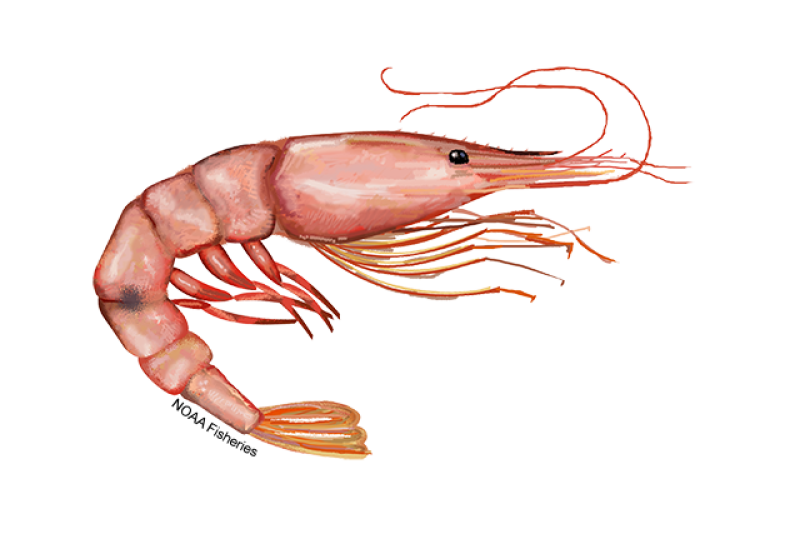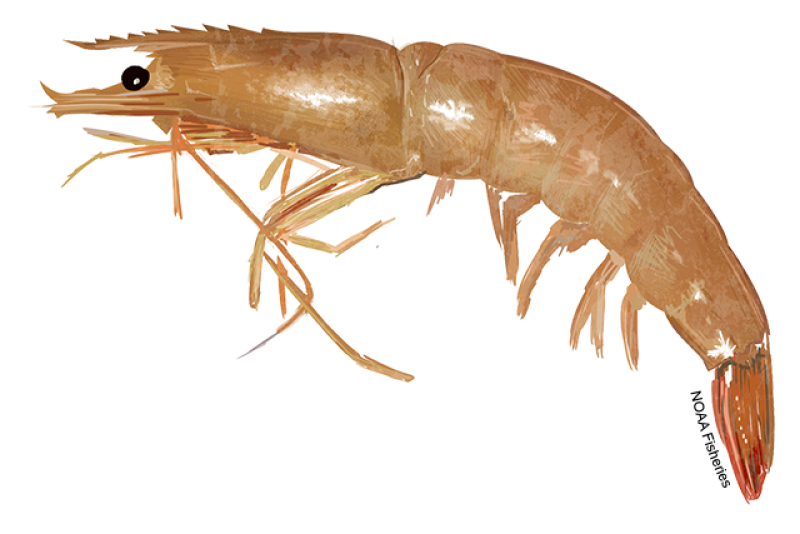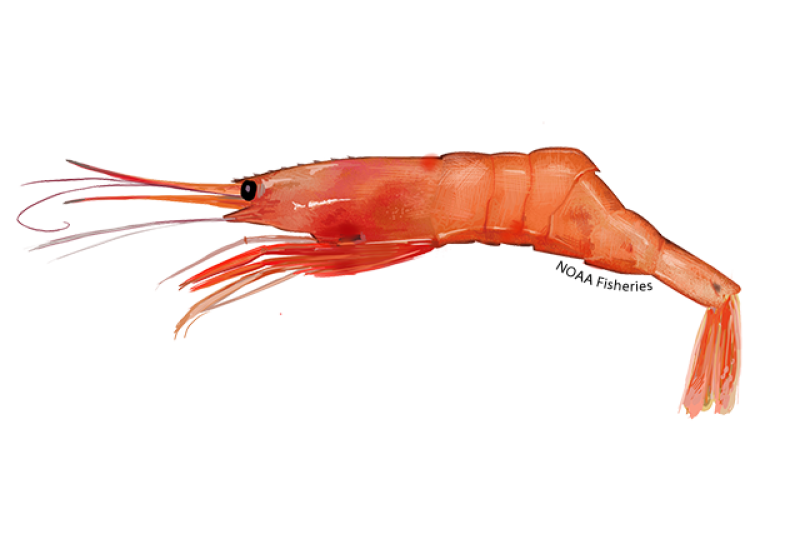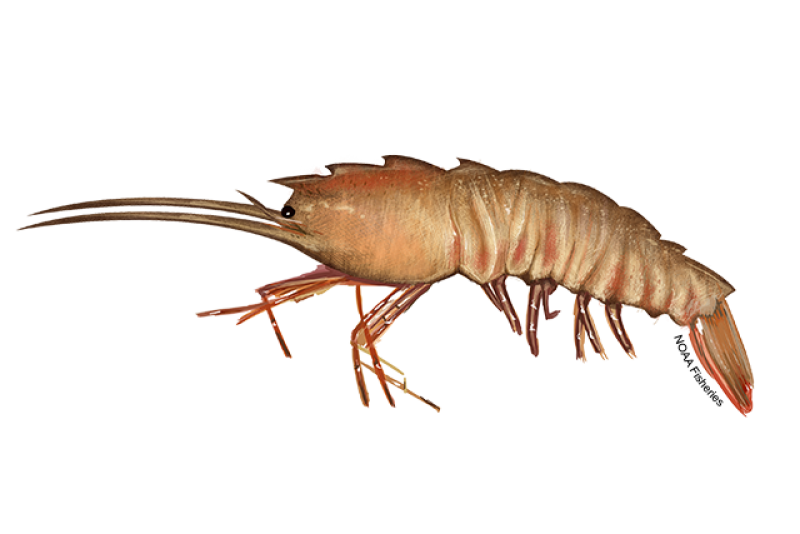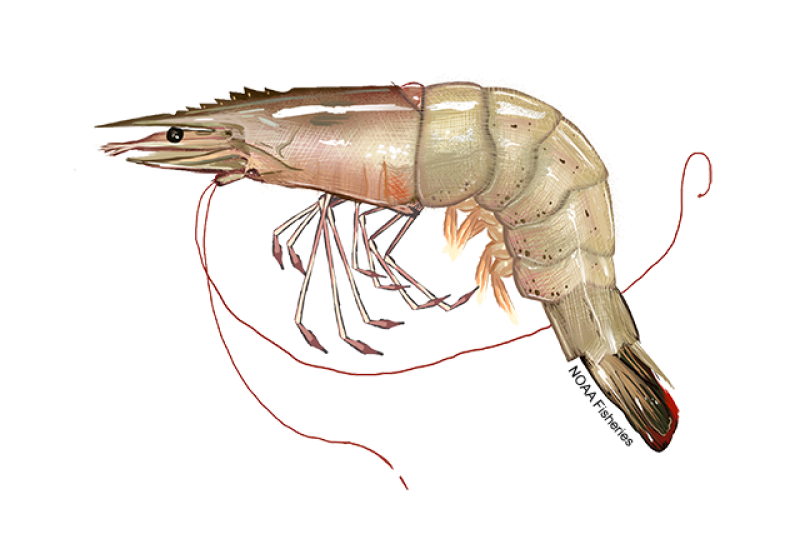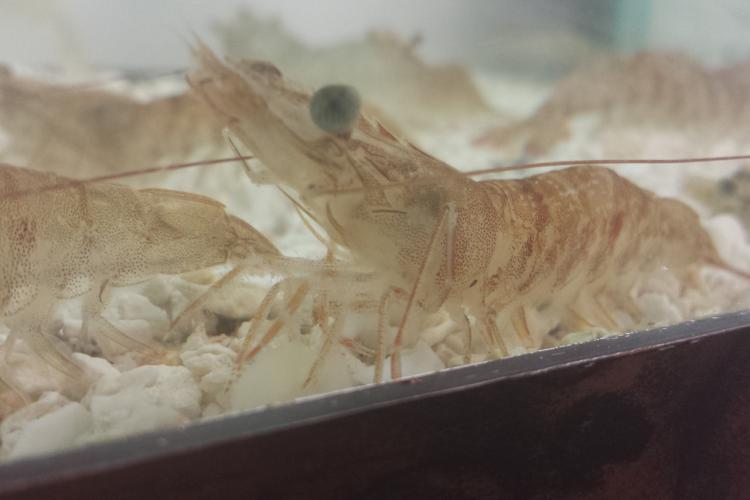 Pink shrimp in tank. Credit: NOAA Fisheries
Pink shrimp in tank. Credit: NOAA Fisheries
Pink shrimp in tank. Credit: NOAA Fisheries
About the Species
 Pink shrimp in tank. Credit: NOAA Fisheries
Pink shrimp in tank. Credit: NOAA Fisheries
Pink shrimp in tank. Credit: NOAA Fisheries
U.S. wild-caught pink shrimp is a smart seafood choice because it is sustainably managed and responsibly harvested under U.S. regulations.

Population
The stocks are not overfished.

Fishing Rate
Not subject to overfishing.

Habitat Impact
Gear restrictions, such as a weak-link in the tickler chain, are in place to protect bottom habitat from trawl gear.

Bycatch
Regulations are in place to minimize bycatch.
Population Status
- There are two stocks of pink shrimp: South Atlantic and Gulf of America* (formerly Gulf of Mexico). According to the most recent stock assessments:
- The South Atlantic stock is not overfished and not subject to overfishing (2018). Summary stock assessment information can be found on Stock SMART.
- The Gulf of America stock is not overfished and not subject to overfishing (2019). Summary stock assessment information can be found on Stock SMART.
Appearance
- Pink shrimp are crustaceans with 10 slender, relatively long walking legs and five pairs of swimming legs, located on the front surface of the abdomen.
- They typically have a dark-colored spot on each side between their third and fourth abdominal segments. Their tail usually has a dark blue band (rather than the purplish band found on brown shrimp).
- Their carapace is grooved.
- Part of their shell is a well-developed, toothed rostrum that extends to or beyond the outer edge of the eyes.
Biology
- Pink shrimp grow fairly fast, depending on factors such as water temperature and salinity, and can reach over 8 inches in length.
- They have a short life span, usually less than 2 years, and are often referred to as an “annual crop.”
- Pink shrimp are able to reproduce when they reach about 3.3 inches long.
- Off North Carolina, they spawn in May through July. In Florida they spawn multiple times, peaking from April through July when the water is warmest.
- Males mate with females and anchor their sperm to the females. Females release about 500,000 to 1 million eggs near the ocean floor, and the eggs are fertilized as they are released.
- Newly hatched shrimp travel to their estuarine nursery habitats in late spring and early summer, propelled by shoreward currents.
- Shrimp that survive the winter grow rapidly in late winter and early spring before returning to the ocean.
- Pink shrimp larvae feed on plankton (tiny floating plants and animals). Juvenile and adult shrimp are omnivorous, feeding on copepods, small mollusks, diatoms, algae, plant detritus, bacterial films, slime molds, and yeast.
- Sheepshead minnows, water boatmen, and insect larvae eat postlarval shrimp, and grass shrimp, killifishes, and blue crabs prey on young shrimp.
- A wide variety of finfish feed heavily on juvenile and adult shrimp.
Where They Live
Range
- Pink shrimp are found from southern Chesapeake Bay to the Florida Keys and around the coast of the Gulf of America to the Yucatan south of Cabo Catoche, Mexico. They’re most abundant off southwestern Florida and the southeastern Gulf of Campeche.
Habitat
- Pink shrimp are commonly found on sand, sand-shell, or coral-mud bottoms.
- Young shrimp live and grow in nursery areas with marsh grasses in the South Atlantic and Gulf of America. These grassy areas offer abundant food and shelter.
- As pink shrimp grow, they migrate seaward to deeper, saltier water. They travel primarily at night, especially around dusk, and bury themselves in the bottom substrate during the day.
- Smaller pink shrimp remain in estuaries during winter and bury themselves deep in the sand or mud to protect themselves from the cold temperatures.
Fishery Management
- NOAA Fisheries and the South Atlantic and Gulf Fishery Management Councils manage the pink shrimp fishery, and state resource management agencies are responsible for inshore state waters.
- In the South Atlantic, managed under the Shrimp Fishery Management Plan for the South Atlantic Region:
- Permits are needed to harvest shrimp in federal waters.
- Fishing trip reports must be submitted for each fishing trip.
- Observers must be carried aboard vessels if selected, to collect data on catch, bycatch, fishing effort, and fishing gear.
- Managers set catch levels based on historic harvest amounts and fishing rates, rather than abundance because pink shrimp are short-lived and heavily influenced by environmental factors.
- In the Gulf of America, managed under the Gulf of America Shrimp Fishery Management Plan:
- Permits are needed to harvest shrimp in federal waters. Currently no new permits are being issued to prevent an increase in the number of boats participating in the fishery.
- Electronic logbooks must be installed and selected fishermen must submit trip reports for each fishing trip.
- Observers must be carried aboard vessels if selected, to collect data on catch, bycatch, fishing effort, and fishing gear.
- Each year all shrimping in federal waters off Texas is closed from approximately mid-May to mid-July to protect brown shrimp populations.
Harvest
- Commercial fishery:
- In 2023, landings of pink shrimp totaled 12.4 million pounds and were valued at over $20 million, according to the NOAA Fisheries commercial fishing landings database.
- The three species of penaeid shrimp (white, pink, and brown) make up the vast majority of the shrimp harvested in the southeast. This fishery is one of the most valuable fisheries in the southeastern United States.
- Over 75 percent of the pink shrimp harvested in the United States comes from the west coast of Florida.
- Annual harvests of pink shrimp vary considerably from year to year, primarily due to environmental conditions. Harvests are much lower in years following severe winter weather.
- Gear types, habitat impacts, and bycatch:
- Commercial fishermen harvest shrimp with trawls towed near the ocean floor. The nets are wide in the front and taper toward the back.
- Shrimpers using otter trawl gear in the South Atlantic and Gulf of America are required to use sea turtle excluder devices (TEDs).
- Some shrimp trawlers must also install bycatch reduction devices behind the TED, to reduce finfish bycatch.
- Area closures if fishing effort exceeds certain thresholds.
- Trawlers in the Gulf of America must have a weak-link in the tickler chain, which hangs in front of the net and drags along the ocean floor to stir up shrimp from the bottom into the net. This weak-link allows the tickler chain to drop away if it gets hung up on natural bottom structures.
- Fishermen do not trawl in areas with coral reefs and other known areas of high-relief to avoid damage to their nets.
- Recreational fishery:
- Under federal management, there is no recognized recreational fishery. Fishing in federal waters requires a permit.
- Recreational fishermen catch pink shrimp seasonally and almost always in state waters. State regulations vary from state to state.
*Executive Order 14172, “Restoring Names That Honor American Greatness” (Jan. 20, 2025), directs that the Gulf of Mexico be renamed the Gulf of America. Gulf of America references in this website refer to the same area as the Gulf of Mexico in the applicable regulations under 50 CFR parts 216–219, 222–226, and 600–699. The name change did not result in any changes to, and had no effect on the applicability or enforceability of, any existing regulations. This website continues to use “Gulf of Mexico” when quoting statutes, existing regulations, or previously published materials.
Scientific Classification
- Pink shrimp are found from southern Chesapeake Bay to the Florida Keys and around the coast of the Gulf of America to the Yucatan south of Cabo Catoche, Mexico. They’re most abundant off southwestern Florida and the southeastern Gulf of Campeche.
- Pink shrimp are commonly found on sand, sand-shell, or coral-mud bottoms.
- Young shrimp live and grow in nursery areas with marsh grasses in the South Atlantic and Gulf of America. These grassy areas offer abundant food and shelter.
- As pink shrimp grow, they migrate seaward to deeper, saltier water. They travel primarily at night, especially around dusk, and bury themselves in the bottom substrate during the day.
- Smaller pink shrimp remain in estuaries during winter and bury themselves deep in the sand or mud to protect themselves from the cold temperatures.
Fishery Management
- NOAA Fisheries and the South Atlantic and Gulf Fishery Management Councils manage the pink shrimp fishery, and state resource management agencies are responsible for inshore state waters.
- In the South Atlantic, managed under the Shrimp Fishery Management Plan for the South Atlantic Region:
- Permits are needed to harvest shrimp in federal waters.
- Fishing trip reports must be submitted for each fishing trip.
- Observers must be carried aboard vessels if selected, to collect data on catch, bycatch, fishing effort, and fishing gear.
- Managers set catch levels based on historic harvest amounts and fishing rates, rather than abundance because pink shrimp are short-lived and heavily influenced by environmental factors.
- In the Gulf of America, managed under the Gulf of America Shrimp Fishery Management Plan:
- Permits are needed to harvest shrimp in federal waters. Currently no new permits are being issued to prevent an increase in the number of boats participating in the fishery.
- Electronic logbooks must be installed and selected fishermen must submit trip reports for each fishing trip.
- Observers must be carried aboard vessels if selected, to collect data on catch, bycatch, fishing effort, and fishing gear.
- Each year all shrimping in federal waters off Texas is closed from approximately mid-May to mid-July to protect brown shrimp populations.
Harvest
- Commercial fishery:
- In 2023, landings of pink shrimp totaled 12.4 million pounds and were valued at over $20 million, according to the NOAA Fisheries commercial fishing landings database.
- The three species of penaeid shrimp (white, pink, and brown) make up the vast majority of the shrimp harvested in the southeast. This fishery is one of the most valuable fisheries in the southeastern United States.
- Over 75 percent of the pink shrimp harvested in the United States comes from the west coast of Florida.
- Annual harvests of pink shrimp vary considerably from year to year, primarily due to environmental conditions. Harvests are much lower in years following severe winter weather.
- Gear types, habitat impacts, and bycatch:
- Commercial fishermen harvest shrimp with trawls towed near the ocean floor. The nets are wide in the front and taper toward the back.
- Shrimpers using otter trawl gear in the South Atlantic and Gulf of America are required to use sea turtle excluder devices (TEDs).
- Some shrimp trawlers must also install bycatch reduction devices behind the TED, to reduce finfish bycatch.
- Area closures if fishing effort exceeds certain thresholds.
- Trawlers in the Gulf of America must have a weak-link in the tickler chain, which hangs in front of the net and drags along the ocean floor to stir up shrimp from the bottom into the net. This weak-link allows the tickler chain to drop away if it gets hung up on natural bottom structures.
- Fishermen do not trawl in areas with coral reefs and other known areas of high-relief to avoid damage to their nets.
- Recreational fishery:
- Under federal management, there is no recognized recreational fishery. Fishing in federal waters requires a permit.
- Recreational fishermen catch pink shrimp seasonally and almost always in state waters. State regulations vary from state to state.
*Executive Order 14172, “Restoring Names That Honor American Greatness” (Jan. 20, 2025), directs that the Gulf of Mexico be renamed the Gulf of America. Gulf of America references in this website refer to the same area as the Gulf of Mexico in the applicable regulations under 50 CFR parts 216–219, 222–226, and 600–699. The name change did not result in any changes to, and had no effect on the applicability or enforceability of, any existing regulations. This website continues to use “Gulf of Mexico” when quoting statutes, existing regulations, or previously published materials.
Scientific Classification
| Kingdom | Animalia | Phylum | Arthropoda | Class | Malacostraca | Order | Decapoda | Family | Penaeidae | Genus | Farfantepenaeus | Species | duorarum |
|---|
Last updated by NOAA Fisheries on 05/22/2025
Featured News
 Celebrate Culinary Arts Month with a sustainable seafood recipe for every month of the year.
Celebrate Culinary Arts Month with a sustainable seafood recipe for every month of the year.
What Your Birth Month Says About Your Next Seafood Recipe
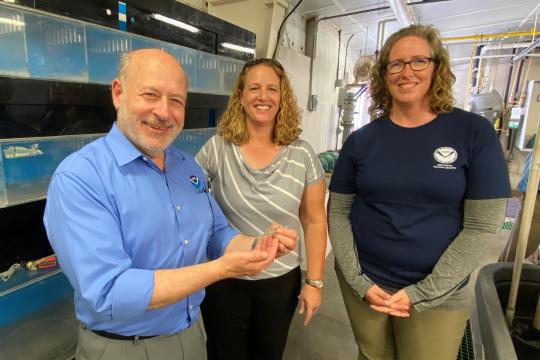 A photo of Jennifer Doerr and Jennifer Leo in the Galveston Laboratory alongside NOAA Administrator Dr. Richard Spinrad. Credit: Keeley Belva/NOAA Fisheries
A photo of Jennifer Doerr and Jennifer Leo in the Galveston Laboratory alongside NOAA Administrator Dr. Richard Spinrad. Credit: Keeley Belva/NOAA Fisheries
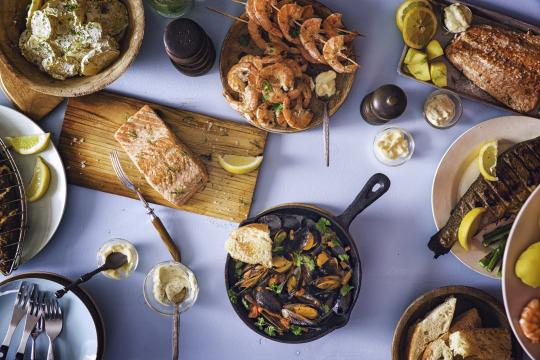 An array of fish and shellfish dishes. Credit: iStock.
An array of fish and shellfish dishes. Credit: iStock.
Seafood Facts

Are Pink Shrimp Sustainable?
U.S. wild-caught pink shrimp is a smart seafood choice because it is sustainably managed and responsibly harvested under U.S. regulations.
Availability
Year-round, with peaks in the winter.
Source
U.S. wild-caught from North Carolina to Texas, but mainly from Florida.
Taste
Flavorful and sweet.
Texture
Tender.
Color
Raw shrimp meat is translucent pink to gray. When cooked, their shells are pinkish-red and their meat is pearly white with pink and red shadings.
Health Benefits
Pink shrimp is low in saturated fat and is a very good source of protein, selenium, and vitamin B12.
Nutrition Facts
Servings: 1; Serving Weight: 100 g (raw); Calories: 106; Protein: 20.31 g; Total Fat: 1.73 g; Total Saturated Fatty Acids: 0.328 g; Carbohydrate: 0.91 g; Total Sugars: 0 g; Total Dietary Fiber: 0 g; Cholesterol: 152 mg; Selenium: 38 mcg; Sodium: 148 mgMore Information
Shrimp Recipes
Looking for some ways to add shrimp into your rotation? If you need cooking inspiration, browse these recipes for shrimp grilled with herb butter, easy sheet pan shrimp fajitas, and more!
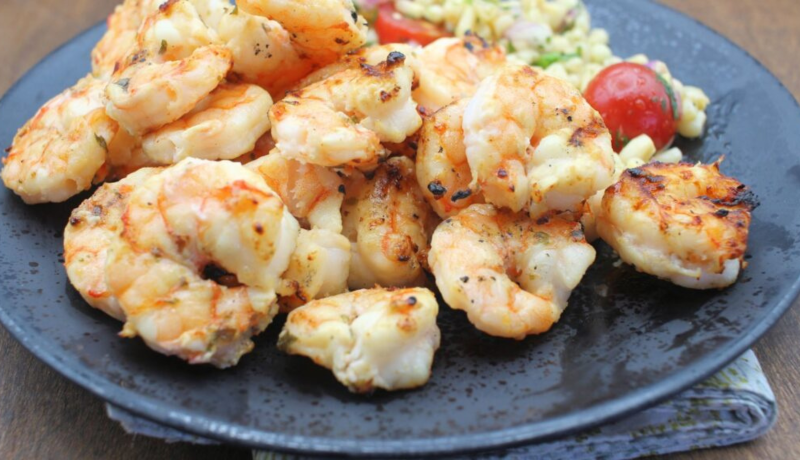
Last updated by NOAA Fisheries on 05/22/2025
Seafood News
 Celebrate Culinary Arts Month with a sustainable seafood recipe for every month of the year.
Celebrate Culinary Arts Month with a sustainable seafood recipe for every month of the year.
What Your Birth Month Says About Your Next Seafood Recipe
 Fresh-caught taʻape on ice. Credit: Conservation International Hawaiʻi.
Fresh-caught taʻape on ice. Credit: Conservation International Hawaiʻi.
Reducing Waste and Feeding Communities in Hawaiʻi with a Whole Fish Approach
 Chef Tyler Hadfield’s Curried Skate Wings with Tomato-Masala Chutney
Chef Tyler Hadfield’s Curried Skate Wings with Tomato-Masala Chutney
Ring In the New Year With These Crowd-Favorite Seafood Recipes
 NOAA Fisheries, in collaboration with Blue Ocean Mariculture, is conducting a multi-year pilot study to evaluate observational methods and tools for studying Hawaiian monk seal behavior. Courtesy of Blue Ocean Mariculture
NOAA Fisheries, in collaboration with Blue Ocean Mariculture, is conducting a multi-year pilot study to evaluate observational methods and tools for studying Hawaiian monk seal behavior. Courtesy of Blue Ocean Mariculture
AI Meets Aquaculture to Study Hawaiian Monk Seal Interactions With Net Pens
Documents
The annual economic survey of federal Gulf shrimp permit holders : report on the design, implementation, and descriptive results for 2006
Christopher Liese, Michael D. Travis, Diana Pina, and James R. Waters
The annual economic survey of federal Gulf shrimp permit holders : implementation and descriptive results for 2007
Christopher Liese, Michael D. Travis, and James R. Waters
The annual economic survey of federal Gulf shrimp permit holders : implementation and descriptive results for 2008
Christopher Liese and Michael D. Travis
Data & Maps
Research
Shrimp Futures Initiative
NOAA’s Southeast Fisheries Science Center is working to understand the profound challenges facing the Southeast’s shrimp fisheries to help prepare for their uncertain future.
Experimental Shrimp Trawl Bycatch Reduction Device
For more information, please contact sustainable fisheries at (727) 824-5305
Last updated by NOAA Fisheries on 05/22/2025
